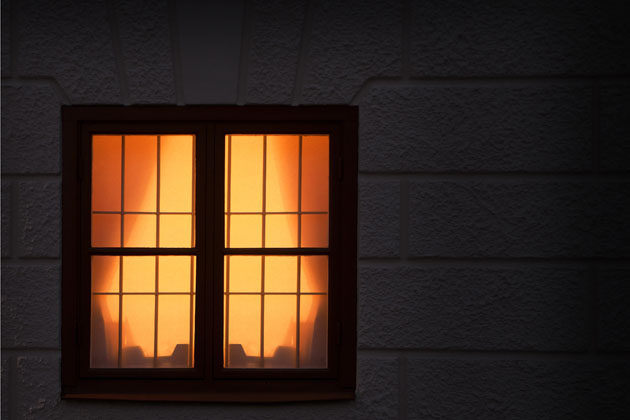
<a href="http://www.shutterstock.com/cat.mhtml?lang=en&search_source=search_form&search_tracking_id=aVWgAM0zueIF2fUu1yrf9g&version=llv1&anyorall=all&safesearch=1&searchterm=house+at+night&search_group=&orient=&search_cat=&searchtermx=&photographer_name=&people_gender=&people_age=&people_ethnicity=&people_number=&commercial_ok=&color=&show_color_wheel=1#id=92666395&src=_8KVFdsKBseoyWefeduwmg-1-48">Amy Johansson</a>/Shutterstock
This story first appeared on the TomDispatch website.
In the wake of the Boston bombings and Newtown massacre, visions of unfathomable crazy mass killers and armed strangers in the night have colonized the American mind. But the danger out there is both more mundane and more terrible: You’re more likely to be hurt or killed by someone you know or love. And you’ll probably be at home when it happens.
Between 2005 and 2010, 60 percent of all violent injuries in this country were inflicted by loved ones or acquaintances. And 60 percent of the time those victimizations happened in the home. In 2011, 79 percent of murders reported to the FBI (in which the victim-offender relationship was known) were committed by friends, loved ones, or acquaintances. And in 2009, most of the homicides for which the FBI has location data were committed in the home. Of the 3.5 million assaults and murders against family members between 1998 and 2002 (the last time such a study was done), almost half were crimes against spouses. Eleven percent were against children. But the majority of violent deaths are self-imposed. Suicide is the leading cause of violent death in the United States, and most of those self-killings happen at home.
Violence Against Women
Vanette has plastic, rose-tinted glasses on and cowrie shells weaved into her braids. Her nails are long and thick and painted purple-brown. She has ample gaps in her teeth, and she’s sitting at the communal dining table at a “transitional home” in Washington, DC, telling me about the time her boyfriend broke her knee.
Vanette doesn’t really think of that as domestic violence, though. “When I think of physical violence, I think of punchin’ and smackin’,” she says. The fat silver chain bracelets on her wrists jangle against the table as she talks. Besides, she says, she was the one who started the fight. Her boyfriend had polyps in his lungs and was supposed to carry around an oxygen tank, flush his lungs twice a week with a machine, and not smoke. One night in 2010, when Vanette got home, there he was, smoking weed in the living room with friends. “I was like, ‘Yeah, well, whatever, you’re gonna kill yourself anyway.'” And then he shoved her over the back of the couch.
Domestic violence is the No. 1 cause of injury to women. The incidents add up to more than all the rapes, muggings, and car accidents women experience each year. One out of every four women in the United States will be physically injured by a lover in her lifetime. That translates into a woman being assaulted every nine seconds in America. Immigrant women are beaten at higher rates than US citizens, and African American women are subjected to the most severe forms of violence. Not surprisingly, a shaky economy just makes these numbers worse.
And then there are the rapes. Over a lifetime, 1 out of every 6 American women is raped. For Native Americans, that number is 1 in 3. For Native Alaskans, it can be up to 12 times the national rate.
And don’t forget the killings. Sixty-four percent of the women killed every year are murdered by family members or lovers. There are more than 1,000 homicides of that kind annually, or approximately three a day. If there’s a gun in a home where domestic abuse is a common thing, a woman is eight times more likely to be killed.
Faced with this grim pile of data, the American home begins to look less like a castle and more like a slaughterhouse.
At the same time, these numbers actually represent a vast improvement in domestic violence rates compared with a decade and a half ago. Since 1994, the rate of violence against women in the home is down 64 percent.
 That percentage isn’t quite as dramatic as it looks, because it coincides with a parallel decline in overall violence during the same period, and excludes the homeless, up to 40 percent of whom report going to the streets or someone’s couch because of violence in the home. Still, the drop is significant and is likely due to, among other things, a public coming to terms with the reality of domestic violence, relatively recent federal laws meant to protect victims in the home, and the training of police and prosecutors to treat such violence as a crime, not a private affair.
That percentage isn’t quite as dramatic as it looks, because it coincides with a parallel decline in overall violence during the same period, and excludes the homeless, up to 40 percent of whom report going to the streets or someone’s couch because of violence in the home. Still, the drop is significant and is likely due to, among other things, a public coming to terms with the reality of domestic violence, relatively recent federal laws meant to protect victims in the home, and the training of police and prosecutors to treat such violence as a crime, not a private affair.
For much of American history, the legal system didn’t recognize most domestic violence, or date rape, or acquaintance rape, or marital rape as crimes. For a century, American men had the explicit right to beat their wives. They lost that right by the late 1870s, but long after that, the police would often respond to reports of wife-beatings by telling the husband to “walk around the block” and cool off. Public aversion to acknowledging violence in the home was so intense for so long that the anti-animal-cruelty movement preceded the anti-domestic-violence movement of the 1960s and 1970s. Even today, a residual urge to respect the supposed sanctity of the home and marriage helps shield men from laws now on the books.
In 1994, Congress passed the Violence Against Women Act (VAWA). It was a landmark in bringing domestic violence out of the house and into the public space. Among other things, it provided money for the legal representation of victims of domestic violence, and for police training on the subject, and it helped enforce judicial restraining orders. The law also funded states to adopt mandatory arrest policies, which require that police arrest suspects in cases in which there is probable cause to believe domestic violence has taken place. Such laws now exist in 22 states and the District of Columbia.
Nationwide, however, arrest rates for domestic violence remain low. Only about half of reported domestic violence incidents result in arrest.
Even when states do have mandatory arrest laws, they don’t always play out so well. If an arrest results in the elimination of the breadwinner in a household, it can leave an already battered woman broke as well. And the threat of certain punishment for a husband or boyfriend can actually make women reluctant to report abuse, which means they remain in violent homes. Immigrant and minority victims are even less inclined to call 911, since they have a stronger distrust of the police. Which means that sometimes mandatory arrest laws can backfire, resulting in fewer arrests, continued violence, and more deaths. A 2007 Harvard study found that the murder rate among domestic partners was 60 percent greater in states with mandatory arrest laws.
Once Vanette had landed on the floor behind the couch with one leg crumpled under her, it was her boyfriend who called 911. He was scared to death. When the ambulance came and the EMTs questioned her, she claimed it had been an accident. (Washington, DC, has a mandatory arrest law). They kept her in the hospital for two days. And then she was on a cane. And out of a job. And shuttling between homeless shelters for months because her girlfriends told her she had to get out of that house.
Violence Against Children
Deon, who is now 27, doesn’t cry. Ever. And he doesn’t get angry. His eyes are wide apart and impassive. He talks matter-of-factly about how, when he was 14, his mother tried to kill him. She said it was because he hadn’t done his homework. One day too many. She lashed him with an extension cord and threw a glass at him. She screamed that she’d call the police and then came at him with a knife. But she missed—deliberately or accidentally—and stabbed the wall instead. He says she meant to hit that wall. His little niece, his two sisters, and his mother’s boyfriend were all in the apartment. His older sister kept pleading, “Mummy, that’s enough.” But no one ever reported the incident.
Child Protective Services may not have gotten a call about Deon, but it does respond to millions of reports of alleged abuse: 3.4 million in 2011. There were 681,000 unique victims that year. Seventy-nine percent of those kids suffered from neglect at home. Eighteen percent were physically abused, and 9 percent were sexually abused. Babies under age one were assaulted most often; 1,570 of those children died from abuse and neglect that year. Eighty-two percent of child victims in 2011 were younger than four.
While the rate of assault on children (as with women) has dropped over the past two decades, a recent Yale School of Medicine study found that serious child abuse—the kind that results in fractures, head injuries, burns, open wounds, or abdominal injuries—is actually up.
Being poor is a good way to increase your chances of being hurt by your parents. The same Yale study of severe abuse found that over the past 12 years, parental punching, thrashing, or burning of children has jumped by 15 percent for kids on Medicaid, the government health insurance program for families in poverty, but by 5 percent for the general population. Another recent Yale study suggested that child Medicaid recipients were six times more likely to be victims of abuse than those not on Medicaid.
Kids in violent homes have sleeping, eating, and attention problems. They are generally more withdrawn, anxious, and depressed than children with parents who don’t abuse them. A 2012 Harvard study of the brain scans of 200 people found that childhood abuse can be associated with damage to the brain’s hippocampus, which plays a major role in short- and long-term memory. Such kids are also more vulnerable to chronic illnesses like heart disease and diabetes, leading some to call child abuse the tobacco industry of mental health. One National Institute of Justice study of 1,500 kids found that abused children were also more likely to become violent criminals.
Child abuse first received national attention in 1874, due to the case of Mary Ellen McCormack, a 10-year-old orphan in Manhattan’s Hell’s Kitchen who was abused by an adoptive mother. No laws then existed to keep parents from beating their children, so the case was brought to court by, yes, the American Society for the Prevention of Cruelty to Animals. “I have now on my head two black-and-blue marks which were made by Mamma with the whip,” McCormack testified, “and a cut on the left side of my forehead which was made by a pair of scissors in Mamma’s hand; she struck me with the scissors and cut me.”
The McCormack case spurred a reformers’ crusade. In 1912, the US Children’s Bureau was created to research and publicize the issue of violence against children. After World War II, more research led to the system of child abuse reporting we have now, in which various professionals—doctors, teachers, day care workers—are required to report suspicions of abuse. Child Protective Services does screenings and investigations and has the power to remove a child from a home, if necessary.
Deon didn’t have his day in court, but even if he had, research shows that, again and again, courts return abused children to parents with a history of violence. A 2005 study by the New England Research Institutes found that, even in states with laws that tilt against custody for an abusive parent, 40 percent of adjudicated wife-beaters got joint custody of children. The American Judges Association says that about 70 percent of wife-abusers are able to convince a court that the mother is unfit for sole custody. Nationwide, some 58,000 children a year are put back into the unsupervised care of alleged abusers after a divorce.
Deon left his mother’s apartment in Brooklyn at 18 and moved in with a coworker in Harlem. He visits his mother maybe once a year. Her place is windowless, wall-to-wall carpeted, and tight with too much furniture. He and his mother don’t ever talk about what happened with the homework and the knife and the wall. When he stops by, he’ll hover in her apartment for 20 minutes or so. And then he has to leave.
Self-Violence
Mark was 25, handsome, rich, and smart. He had a trust fund and spent $10,000 of it a month. He was really popular—there must have been 400 people at his funeral.
When Mark was a kid, his father once made him cry for not finishing a sandwich in a restaurant. He also showed him just how to treat his mother and younger brother, so that Mark would grow up to be a good bully, too. When he graduated from college, his dad insisted that he also go to law school. But he couldn’t get in.
Mark started binge drinking at age 13. He had a history of getting into trouble (at school, with the law), but his dad was usually able to get him out of it—until the bar fight that landed a guy in the hospital. A couple of weeks after that, Mark was drunk at his apartment and fighting with his girlfriend. His dad had given him a .38 revolver because he thought the upscale neighborhood Mark lived in was dangerous. He pulled out the gun and shot himself. In his eulogy, his dad told the congregation that Mark was trying to live up to him and couldn’t do it.
Of the approximately 55,000 people each year who die a violent death in the United States, most—like Mark—take their own lives: about 38,000 annually. Suicide is the 10th leading cause of American death, behind cancer and heart attacks but ahead of car accidents. There is a suicide every 13.7 minutes. And 77 percent of the time, as in Mark’s case, it happens at home. In 2010, the highest suicide rate was among 45- to 64-year-olds. Men kill themselves four times more often than women, whites more often than other races.
There are known contributors. Ninety percent of those who kill themselves have mental disorders. Many have physical pain. Being unemployed is associated with as much as a three-fold increased risk of death by suicide. Having a means of suicide in the home, like a gun, also makes it more likely to happen. In that sense, Mark killed himself in the most common way.
Often enough, suicides fail. Nearly 1 million people attempt suicide every year. In 2010, 464,995 people visited a hospital for injuries due to suicidal behavior. Even though men succeed in killing themselves more often, women attempt suicide three times as often as men. According to researchers, that’s because a woman is more likely to use the act as a cry for help, rather than to end her life.
Suicide is not a pretty thing to talk about. That’s one reason why federal policy on suicide prevention is still in its infancy. A movement organized by the families and friends of victims began to build throughout the 1990s, however, and eventually got the attention of Surgeon General David Satcher. In 2001, he laid out the first national strategy for suicide prevention. But 12 years later, advocates say federal funding for suicide prevention and research is still insufficient.
Oddly enough, since the federal government instituted its response, suicide rates have been climbing. The national suicide rate had been on the decline for decades: Between 1990 and 2000, it dropped from 12.5 to 10.4 deaths per 100,000. In the next decade, it started to rise again and stood at 12.1 per 100,000 in 2010.
Suicide is up. Severe child abuse is on the rise. Domestic violence is still the No. 1 injurer of women. The classic notion of the home as a refuge, not an abattoir, seems more and more like a joke.
Feel free to cut through that dark alley on your way home. Or maybe just don’t go home.
Note to readers: The names of the three victims portrayed in this piece have been changed.
Erika Eichelberger is a reporting fellow at Mother Jones, where she writes regularly for the website. She is also director of social media for TomDispatch. She has written for The Nation, the Brooklyn Rail, and Alternet.
Follow TomDispatch on Twitter and join us on Facebook or Tumblr. Check out the newest Dispatch book, Nick Turse’s The Changing Face of Empire: Special Ops, Drones, Proxy Fighters, Secret Bases, and Cyberwarfare. To stay on top of important articles like these, sign up to receive the latest updates from TomDispatch.com here.
















